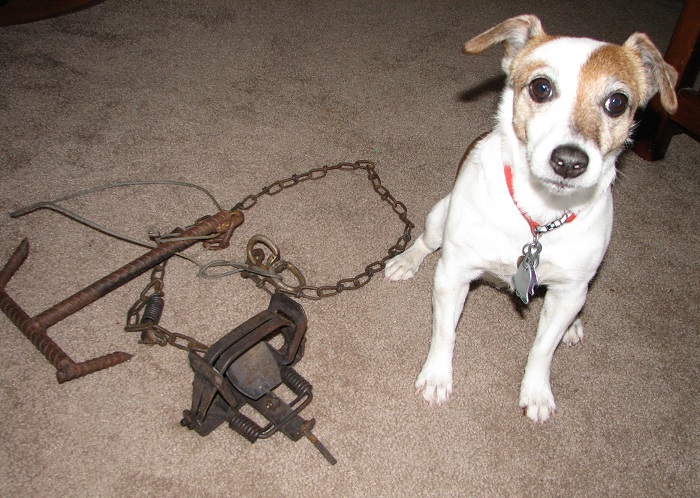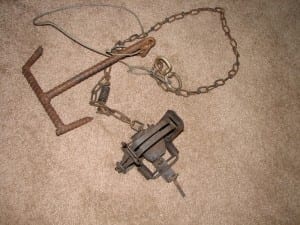 Originally published on Jan. 16, 2014
Originally published on Jan. 16, 2014
Written by Cami Cox
Imagine you’re enjoying a walk in a local recreation area. It’s a nice day out, your family members are in tow and you have your pet dog on a leash. Suddenly, you hear a loud snap – and your outing has just ended because you realize your dog has stepped in an animal trap.
That’s what happened to Hurricane resident Walter Crovo on Jan. 4 when he, his wife, Cathy, and their dog Chili were out walking through BLM land just west of Gunlock Reservoir.
“I heard that snap and I turned around and looked in that little dog’s eyes,” Walter Crovo said. “I freaked out.”
In a recreation area frequented by local people, the Crovos’ Jack Russell terrier had stepped in a bobcat trap. Though the small dog’s leg ultimately wasn’t found to be broken, it was swollen and sore and she limped around for several days.
“I can’t believe this is legal, where the public hikes,” Cathy Crovo said. “That could’ve been my grandchild.”
But not only is it legal for hunters to place traps in public areas, it is encouraged to help keep certain animal populations under control.
“We somewhat rely on trappers to help manage predator populations,” said Mark Ekins, a local game warden with the Division of Wildlife.
 Though hunting and trapping guidelines published by the Utah Division of Wildlife Resources state that trappers “have an ethical obligation not to set traps in areas where they are likely to be encountered by the general public or their pets,” there are currently no state laws in place mandating that trappers keep their traps away from publicly frequented areas. One section of the UDWR guidebook for trapping furbearing animals says trappers should “avoid setting traps near trails that are frequently used by people and dogs,” but even that brief admonition doesn’t specify how far from public trails the traps should be placed, and there is currently no law in place to enforce the guideline.
Though hunting and trapping guidelines published by the Utah Division of Wildlife Resources state that trappers “have an ethical obligation not to set traps in areas where they are likely to be encountered by the general public or their pets,” there are currently no state laws in place mandating that trappers keep their traps away from publicly frequented areas. One section of the UDWR guidebook for trapping furbearing animals says trappers should “avoid setting traps near trails that are frequently used by people and dogs,” but even that brief admonition doesn’t specify how far from public trails the traps should be placed, and there is currently no law in place to enforce the guideline.
“They can put a trap anywhere they want – sensitive archeological sites, off trails, anywhere,” Walter Crovo said. “It is crazy.”
“I guess if the hunters were prudent you wouldn’t have to worry about that, but they’re not,” he added. “They can put them anywhere.”
Some cities in Utah have enacted laws that restrict the use of steel-jawed traps, Ekins said. But on a statewide level, only a few restrictions exist regarding where hunters can place them. According to the UDWR website, trapping is prohibited on posted private land, unless the trapper has permission to be there; trapping is prohibited on Native American tribal lands, unless the trapper has permission from local tribal leaders; and trapping is prohibited in state parks, except those designated for open hunting by the Division of Parks and Recreation. Otherwise, as far as the law is concerned, hunters can place traps wherever they want.
“Most of them try to get away from trails,” Ekins said, “but just like in anything, there’s always those who mess up.”
“Those who are doing it correctly are an asset to the state,” he added, “and those who aren’t obviously aren’t an asset to us or to the public.”
Ekins said trapping is highly regulated in Utah. There are guidelines that restrict the types of traps that can be used, stipulate how frequently traps must be checked, designate legal trapping seasons for different animals and require hunters to register and tag their traps. The type of trap the Crovos’ dog got caught in is a legal trap called a leghold trap, and Ekins said it won’t hurt a child and is designed to cause little or no injury to an animal.
 “When used correctly, they cause very little damage, if any, to an animal’s foot,” he said.
“When used correctly, they cause very little damage, if any, to an animal’s foot,” he said.
Walter Crovo, who said he cut himself trying to free his dog from the trap, said it’s true that his dog wasn’t killed or permanently injured – but the whole ordeal left him and his wife very upset and their dog hurt and scared.
“Supposedly those traps are designed not to kill or maim innocent victims, so the trap worked correctly if you look at it that way,” Crovo said.
He added that he personally doesn’t believe in hunting, but he knows others do and it’s their right to do it. But he said he wants to see laws put in place that will prevent hunters from placing their traps where people and pets go.
“I’m not going to try to change anybody from wanting to hunt,” he said. “Go ahead and hunt, put your traps up. Just don’t put them where people are.”
After freeing his dog, Crovo removed the trap from the site and immediately called local officials to tell them what had happened. He was startled to find out that he could be prosecuted for taking the trap. He said that, ultimately, officials at the Division of Wildlife were understanding and no charges were filed against him for removing it, but the UDWR guidebook states that rewards of up to $500 are offered against trap thieves, and individuals who encounter traps outdoors “have a legal obligation to respect that private property.”
Crovo said he has a friend in Apple Valley whose pet was also caught in a trap, and the hunter who owned the trap threatened to sue her for removing it.
Ekins said people need to be aware that a large number of traps are placed in local outdoor areas during bobcat trapping season, which takes place each year from Nov. 27 to Feb. 2. It is during this time that most incidents, like the one the Crovos experienced, occur.
“I can’t think of a single time that I’ve had an animal stuck in a leghold outside of that timeframe,” he said.
Though some other types of animals, including muskrats, red foxes and striped skunks, can be trapped year-round, Ekins said most trappers hold out for bobcat season.
“Most all my issues that I can think of off the top of my head start when bobcat season begins,” he said.
He added if a pet does get caught in a leghold trap, the best thing to do is first calm the animal down, then try releasing the trap using your feet. Finally, rub the animal’s leg once it’s free. Leave the trap there, he added, and call the “Help Stop Poaching” hotline at 800-662-3337. Washington County residents can also call non-emergency dispatch at (435) 634-5730.
“I’ll respond to that area and verify that the trap is legal,” he said. If it’s not, the owner of the trap will be located via the identification tag on the trap and will be cited or arrested for poaching.
For the Crovos, it’s going to be difficult to hike and recreate in favorite local spots without remembering this incident. And for Walter Crovo, fighting to have laws put in place that will prevent this from happening to other people and their pets has become a priority.
“I’ll go as far as I need to to try and get this changed,” he said. “All you have to do is look in my dog’s eyes and you’d try, too.”
RELATED ARTICLES
A Celebration of Murder: Yulin’s Dog Meat Festival
Best Friends Animal Society named a 2016 “Brand of the Year” by Harris Poll
Beauty is pain: Cosmetic animal testing and cruelty-free products






